Enhancement of Long-Range Surface Plasmon Excitation, Dynamic Range and Figure of Merit Using a Dielectric Resonant Cavity
Abstract
:1. Introduction
2. Structure and Simulation Methods
2.1. Simulation Methods
2.2. Terms and Definitions
3. Results and Discussion
3.1. LRSPP and SRSPP
3.2. IIMI Structure for LRSPP Excitation through Evanescent Wave Coupling
3.3. LRSPP Excited by the Dielectric Resonator
3.4. Key Properties of LRSPP Excited in IIMI Structure
3.5. Field Enhancement
3.6. Self-Referenced SPR System
4. Conclusions
Supplementary Materials
Author Contributions
Funding
Acknowledgments
Conflicts of Interest
References
- Schasfoort, R.B. Handbook of Surface Plasmon Resonance; Royal Society of Chemistry: London, UK, 2017. [Google Scholar]
- Mayer, K.M.; Lee, S.; Liao, H.; Rostro, B.C.; Fuentes, A.; Scully, P.T.; Nehl, C.L.; Hafner, J.H. A label-free immunoassay based upon localized surface plasmon resonance of gold nanorods. ACS Nano 2008, 2, 687–692. [Google Scholar] [CrossRef] [PubMed]
- Ferreira de Macedo, E.; Ducatti Formaggio, D.M.; Salles Santos, N.; Batista Tada, D. Gold nanoparticles used as protein scavengers enhance surface plasmon resonance signal. Sensors 2017, 17, 2765. [Google Scholar] [CrossRef] [PubMed]
- Zeng, S.; Baillargeat, D.; Ho, H.P.; Yong, K.T. Nanomaterials enhanced surface plasmon resonance for biological and chemical sensing applications. Chem. Soc. Rev. 2014, 43, 3426–3452. [Google Scholar] [CrossRef] [PubMed]
- Kretschmann, E. The determination of the optical constants of metals by excitation of surface plasmons. Z. Phys. 1971, 241, 313–324. [Google Scholar] [CrossRef]
- Kretschmann, E.; Raether, H. Radiative decay of non radiative surface plasmons excited by light. Z. Naturforsch. A 1968, 23, 2135–2136. [Google Scholar] [CrossRef]
- Otto, A. Excitation of nonradiative surface plasma waves in silver by the method of frustrated total reflection. Z. Phys. A Hadrons Nuclei 1968, 216, 398–410. [Google Scholar] [CrossRef]
- Lysenko, O.; Bache, M.; Olivier, N.; Zayats, A.V.; Lavrinenko, A. Nonlinear dynamics of ultrashort long-range surface plasmon polariton pulses in gold strip waveguides. ACS Photonics 2016, 3, 2324–2329. [Google Scholar] [CrossRef]
- Shen, M.; Learkthanakhachon, S.; Pechprasarn, S.; Zhang, Y.; Somekh, M.G. Adjustable microscopic measurement of nanogap waveguide and plasmonic structures. Appl. Opt. 2018, 57, 3453–3462. [Google Scholar] [CrossRef] [PubMed]
- Zhao, X.; Zhang, Z.; Yan, S. Tunable fano resonance in asymmetric mim waveguide structure. Sensors 2017, 17, 1494. [Google Scholar] [CrossRef] [PubMed]
- Yu, J.; Ohtera, Y.; Yamada, H. Scattering-parameter model analysis of side-coupled plasmonic fabry–perot waveguide filters. Appl. Phys. A 2018, 124, 516. [Google Scholar] [CrossRef]
- Berini, P. Long-range surface plasmon polaritons. Adv. Opt. Photonics 2009, 1, 484–588. [Google Scholar] [CrossRef]
- Lee, K.-S.; Lee, T.S.; Kim, I.; Kim, W.M. Parametric study on the bimetallic waveguide coupled surface plasmon resonance sensors in comparison with other configurations. J. Phys. D Appl. Phys. 2013, 46, 125302. [Google Scholar] [CrossRef]
- Slavík, R.; Homola, J. Ultrahigh resolution long range surface plasmon-based sensor. Sens. Actuators B Chem. 2007, 123, 10–12. [Google Scholar] [CrossRef]
- Meng, Q.-Q.; Zhao, X.; Lin, C.-Y.; Chen, S.-J.; Ding, Y.-C.; Chen, Z.-Y. Figure of merit enhancement of a surface plasmon resonance sensor using a low-refractive-index porous silica film. Sensors 2017, 17, 1846. [Google Scholar] [CrossRef] [PubMed]
- Khan, M.R.; Khalilian, A.; Kang, S.W. Fast, highly-sensitive, and wide-dynamic-range interdigitated capacitor glucose biosensor using solvatochromic dye-containing sensing membrane. Sensors 2016, 16, 265. [Google Scholar] [CrossRef] [PubMed]
- Zeng, S.; Sreekanth, K.V.; Shang, J.; Yu, T.; Chen, C.K.; Yin, F.; Baillargeat, D.; Coquet, P.; Ho, H.P.; Kabashin, A.V.; et al. Graphene-gold metasurface architectures for ultrasensitive plasmonic biosensing. Adv. Mater. 2015, 27, 6163–6169. [Google Scholar] [CrossRef] [PubMed]
- Wu, C.-T.; Huang, C.-C.; Lee, Y.-C. Plasmonic wavelength demultiplexer with a ring resonator using high-order resonant modes. Appl. Opt. 2017, 56, 4039–4044. [Google Scholar] [CrossRef] [PubMed]
- Lan, T.-H.; Chung, Y.-K.; Tien, C.-H. Broad detecting range of objective-based surface plasmon resonance sensor via multilayer structure. Jpn. J. Appl. Phys. 2011, 50, 09MG04. [Google Scholar] [CrossRef]
- Abeles, F.; Lopez-Rios, T. Decoupled optical excitation of surface plasmons at the two surfaces of a thin film. Opt. Commun. 1974, 11, 89–92. [Google Scholar] [CrossRef]
- Botten, L.; White, T.; de Sterke, C.M.; McPhedran, R.; Asatryan, A.; Langtry, T. Photonic crystal devices modelled as grating stacks: Matrix generalizations of thin film optics. Opt. Express 2004, 12, 1592–1604. [Google Scholar] [CrossRef] [PubMed]
- Moharam, M.G.; Gaylord, T.K. Rigorous coupled-wave analysis of planar-grating diffraction. J. Opt. Soc. Am. 1981, 71, 811–818. [Google Scholar] [CrossRef]
- Berini, P. Figures of merit for surface plasmon waveguides. Opt. Express 2006, 14, 13030–13042. [Google Scholar] [CrossRef] [PubMed]
- Saha, K.; Agasti, S.S.; Kim, C.; Li, X.; Rotello, V.M. Gold nanoparticles in chemical and biological sensing. Chem. Rev. 2012, 112, 2739–2779. [Google Scholar] [CrossRef] [PubMed]
- Johnson, P.B.; Christy, R.W. Optical constants of the noble metals. Phys. Rev. B 1972, 6, 4370–4379. [Google Scholar] [CrossRef]
- Yang, M.K.; French, R.H.; Tokarsky, E.W. Optical properties of teflon® AF amorphous fluoropolymers. J. Micro/Nanolithogr. MEMS MOEMS 2008, 7, 033010. [Google Scholar] [CrossRef]
- Li, H. Refractive index of alkali halides and its wavelength and temperature derivatives. J. Phys. Chem. Ref. Data 1976, 5, 329–528. [Google Scholar] [CrossRef]
- Stegeman, G.; Burke, J.; Hall, D. Surface-polaritonlike waves guided by thin, lossy metal films. Opt. Lett. 1983, 8, 383–385. [Google Scholar] [CrossRef] [PubMed]
- Trapp, J. Design and Fabrication of a Long-Range Surface Plasmon Polariton Wave Guide for Near-Infrared Light; LMU München: Munich, Germany, 2011. [Google Scholar]
- Pechprasarn, S.; Learkthanakhachon, S.; Zheng, G.; Shen, H.; Lei, D.Y.; Somekh, M.G. Grating-coupled otto configuration for hybridized surface phonon polariton excitation for local refractive index sensitivity enhancement. Opt. Express 2016, 24, 19517–19530. [Google Scholar] [CrossRef] [PubMed]
- Saleh, B.E.; Teich, M.C.; Saleh, B.E. Fundamentals of Photonics; Wiley: New York, NY, USA, 1991; Volume 22. [Google Scholar]
- Yakubovsky, D.I.; Arsenin, A.V.; Stebunov, Y.V.; Fedyanin, D.Y.; Volkov, V.S. Optical constants and structural properties of thin gold films. Opt. Express 2017, 25, 25574–25587. [Google Scholar] [CrossRef] [PubMed]
- Kossoy, A.; Merk, V.; Simakov, D.; Leosson, K.; Kéna-Cohen, S.; Maier, S.A. Optical and structural properties of ultra-thin gold films. Adv. Opt. Mater. 2015, 3, 71–77. [Google Scholar] [CrossRef]
- Azeredo, B.P.; Yeratapally, S.R.; Kacher, J.; Ferreira, P.M.; Sangid, M.D. An experimental and computational study of size-dependent contact-angle of dewetted metal nanodroplets below its melting temperature. Appl. Phys. Lett. 2016, 109, 213101. [Google Scholar] [CrossRef] [Green Version]
- Tu, J.; Homes, C.; Strongin, M. Optical properties of ultrathin films: Evidence for a dielectric anomaly at the insulator-to-metal transition. Phys. Rev. Lett. 2003, 90, 017402. [Google Scholar] [CrossRef] [PubMed]
- Laref, S.; Cao, J.; Asaduzzaman, A.; Runge, K.; Deymier, P.; Ziolkowski, R.W.; Miyawaki, M.; Muralidharan, K. Size-dependent permittivity and intrinsic optical anisotropy of nanometric gold thin films: A density functional theory study. Opt. Express 2013, 21, 11827–11838. [Google Scholar] [CrossRef] [PubMed]
- Olmon, R.L.; Slovick, B.; Johnson, T.W.; Shelton, D.; Oh, S.-H.; Boreman, G.D.; Raschke, M.B. Optical dielectric function of gold. Phys. Rev. B 2012, 86, 235147. [Google Scholar] [CrossRef] [Green Version]
- Zhou, Y.; Chan, K.K.; Lai, T.; Tang, S. Characterizing refractive index and thickness of biological tissues using combined multiphoton microscopy and optical coherence tomography. Biomed. Opt. Express 2013, 4, 38–50. [Google Scholar] [CrossRef] [PubMed]
- Jin, Y.; Chen, J.; Xu, L.; Wang, P. Refractive index measurement for biomaterial samples by total internal reflection. Phys. Med. Biol. 2006, 51, N371. [Google Scholar] [CrossRef] [PubMed]
- Wazawa, T.; Ueda, M. Total internal reflection fluorescence microscopy in single molecule nanobioscience. In Microscopy Techniques; Springer: Berlin/Heidelberg, Germany, 2005; pp. 77–106. [Google Scholar]
- Jamil, M.M.A.; Denyer, M.C.; Youseffi, M.; Britland, S.T.; Liu, S.; See, C.; Somekh, M.; Zhang, J. Imaging of the cell surface interface using objective coupled widefield surface plasmon microscopy. J. Struct. Biol. 2008, 164, 75–80. [Google Scholar] [CrossRef] [PubMed] [Green Version]
- Bauch, M.; Toma, K.; Toma, M.; Zhang, Q.; Dostalek, J. Plasmon-enhanced fluorescence biosensors: A review. Plasmonics 2014, 9, 781–799. [Google Scholar] [CrossRef] [PubMed]
- Huck, A.; Witthaut, D.; Kumar, S.; Sørensen, A.S.; Andersen, U.L. Large optical nonlinearity of surface plasmon modes on thin gold films. Plasmonics 2013, 8, 1597–1605. [Google Scholar] [CrossRef]
- Byrne, G.D.; Vllasaliu, D.; Falcone, F.H.; Somekh, M.G.; Stolnik, S. Live imaging of cellular internalization of single colloidal particle by combined label-free and fluorescence total internal reflection microscopy. Mol. Pharm. 2015, 12, 3862–3870. [Google Scholar] [CrossRef] [PubMed] [Green Version]
- Byrne, G.; Pitter, M.; Zhang, J.; Falcone, F.; Stolnik, S.; Somekh, M. Total internal reflection microscopy for live imaging of cellular uptake of sub-micron non-fluorescent particles. J. Microsc. 2008, 231, 168–179. [Google Scholar] [CrossRef] [PubMed] [Green Version]
- Zhang, B.; Pechprasarn, S.; Zhang, J.; Somekh, M.G. Confocal surface plasmon microscopy with pupil function engineering. Opt. Express 2012, 20, 7388–7397. [Google Scholar] [CrossRef] [PubMed]
- Pechprasarn, S.; Zhang, B.; Albutt, D.; Zhang, J.; Somekh, M. Ultrastable embedded surface plasmon confocal interferometry. Light Sci. Appl. 2014, 3, e187. [Google Scholar] [CrossRef]
- Zhang, B.; Pechprasarn, S.; Somekh, M.G. Quantitative plasmonic measurements using embedded phase stepping confocal interferometry. Opt. Express 2013, 21, 11523–11535. [Google Scholar] [CrossRef] [PubMed]
- Zhang, B.; Pechprasarn, S.; Somekh, M.G. Surface plasmon microscopic sensing with beam profile modulation. Opt. Express 2012, 20, 28039–28048. [Google Scholar] [CrossRef] [PubMed]
- Dan, D.; Lei, M.; Yao, B.; Wang, W.; Winterhalder, M.; Zumbusch, A.; Qi, Y.; Xia, L.; Yan, S.; Yang, Y. Dmd-based led-illumination super-resolution and optical sectioning microscopy. Sci. Rep. 2013, 3, 1116. [Google Scholar] [CrossRef] [PubMed]
- Li, D.; Shao, L.; Chen, B.-C.; Zhang, X.; Zhang, M.; Moses, B.; Milkie, D.E.; Beach, J.R.; Hammer, J.A.; Pasham, M. Extended-resolution structured illumination imaging of endocytic and cytoskeletal dynamics. Science 2015, 349, aab3500. [Google Scholar] [CrossRef] [PubMed]
- Malitson, I.H. Interspecimen comparison of the refractive index of fused silica. J. Opt. Soc. Am. 1965, 55, 1205–1209. [Google Scholar] [CrossRef]
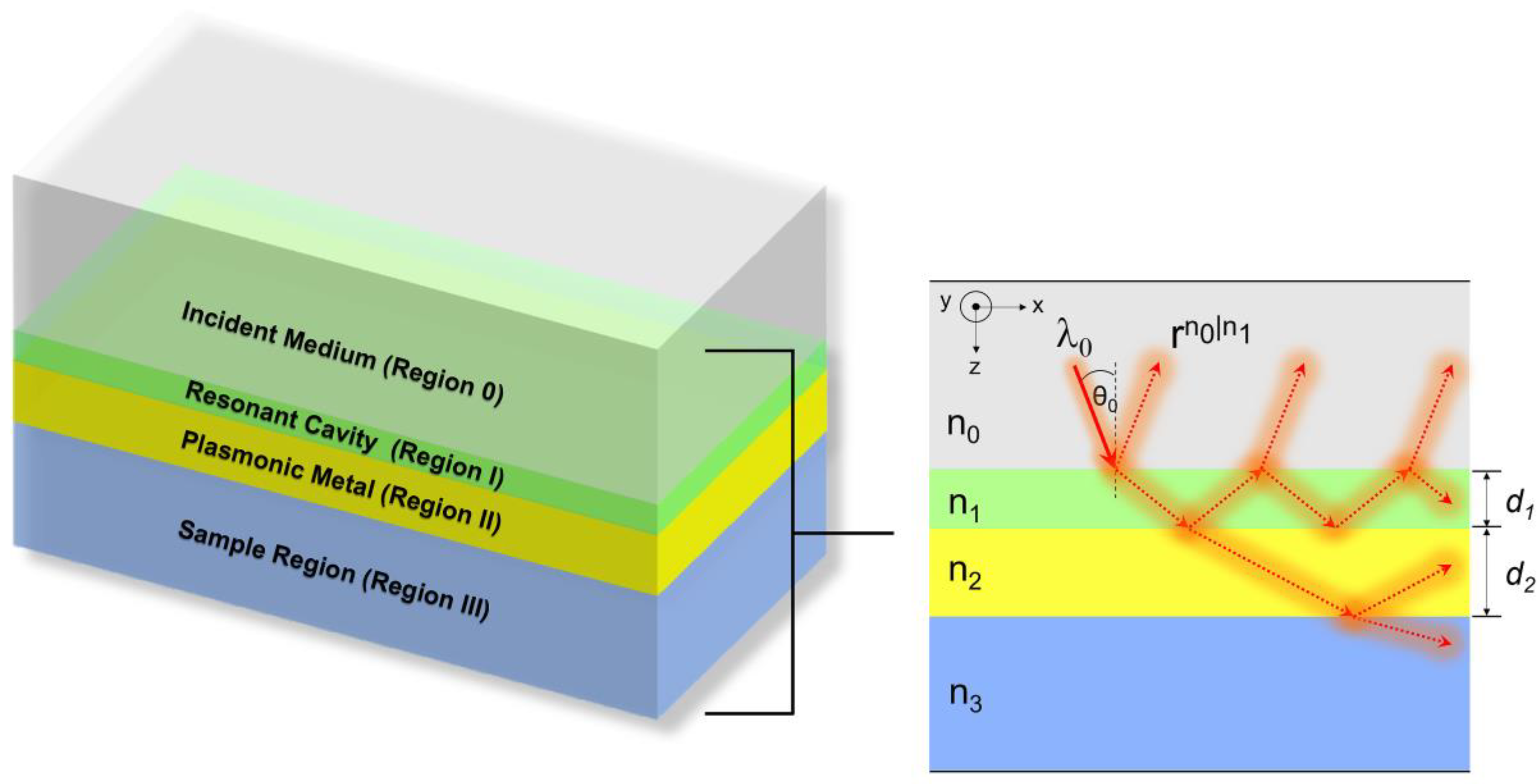



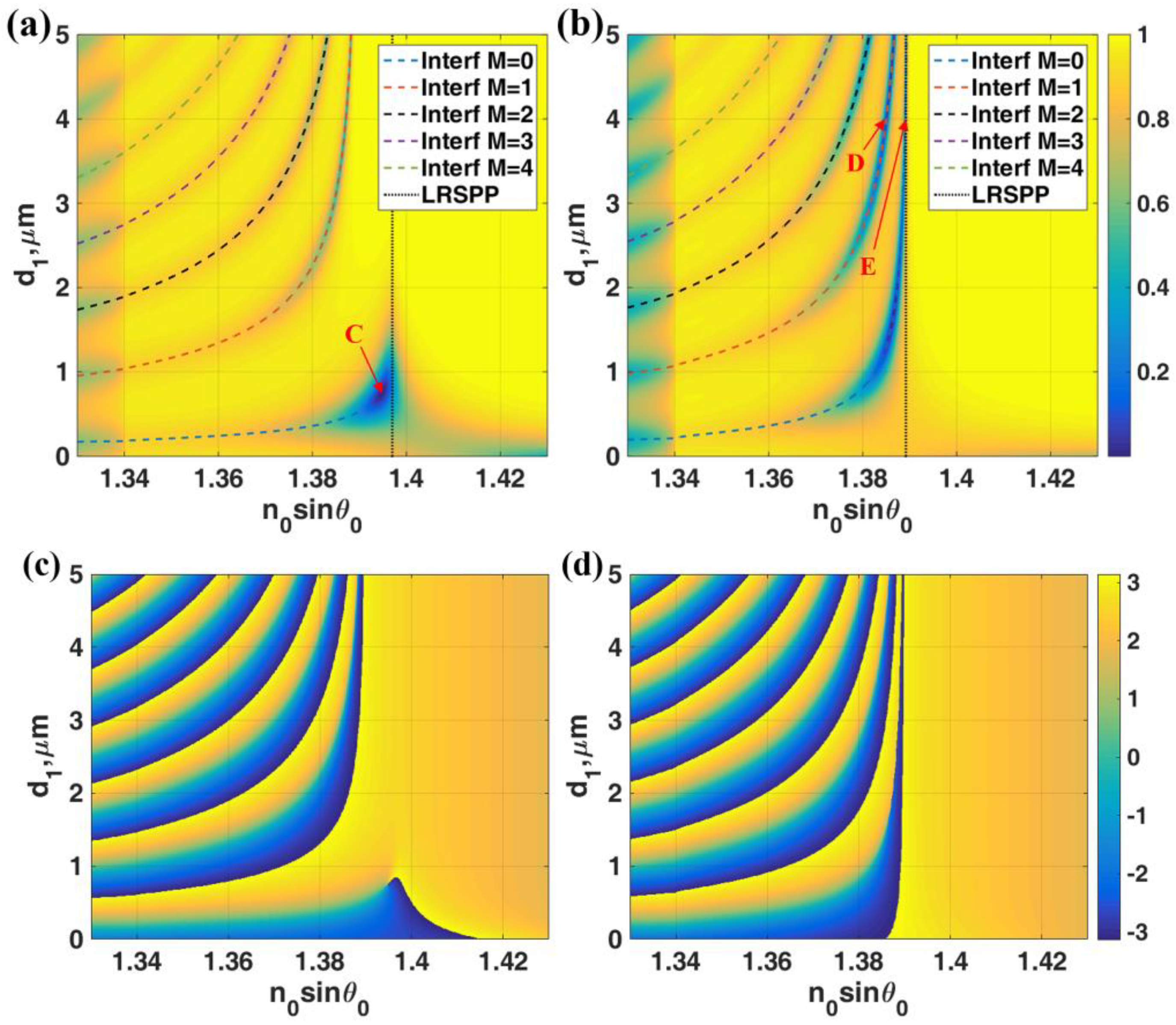
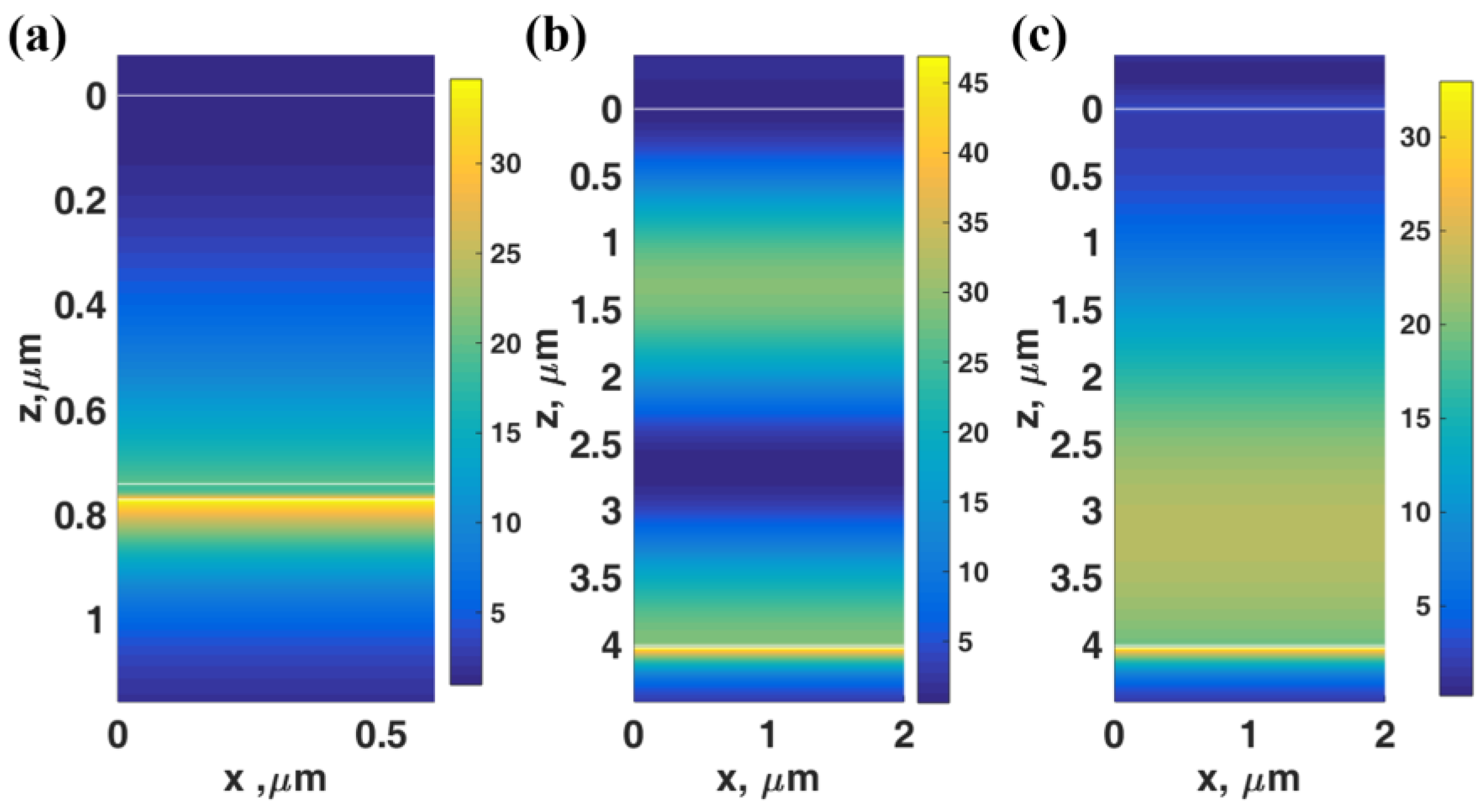
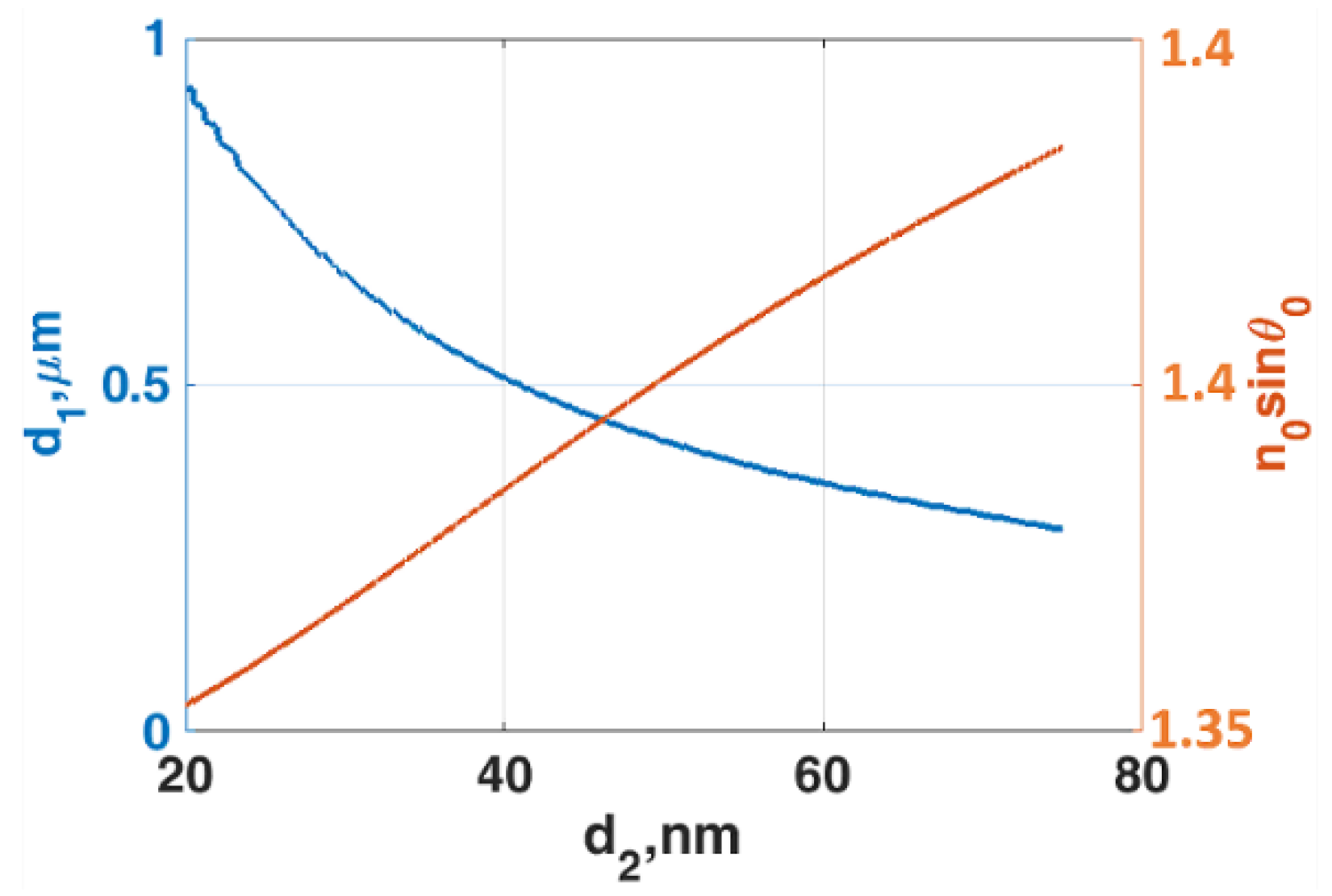
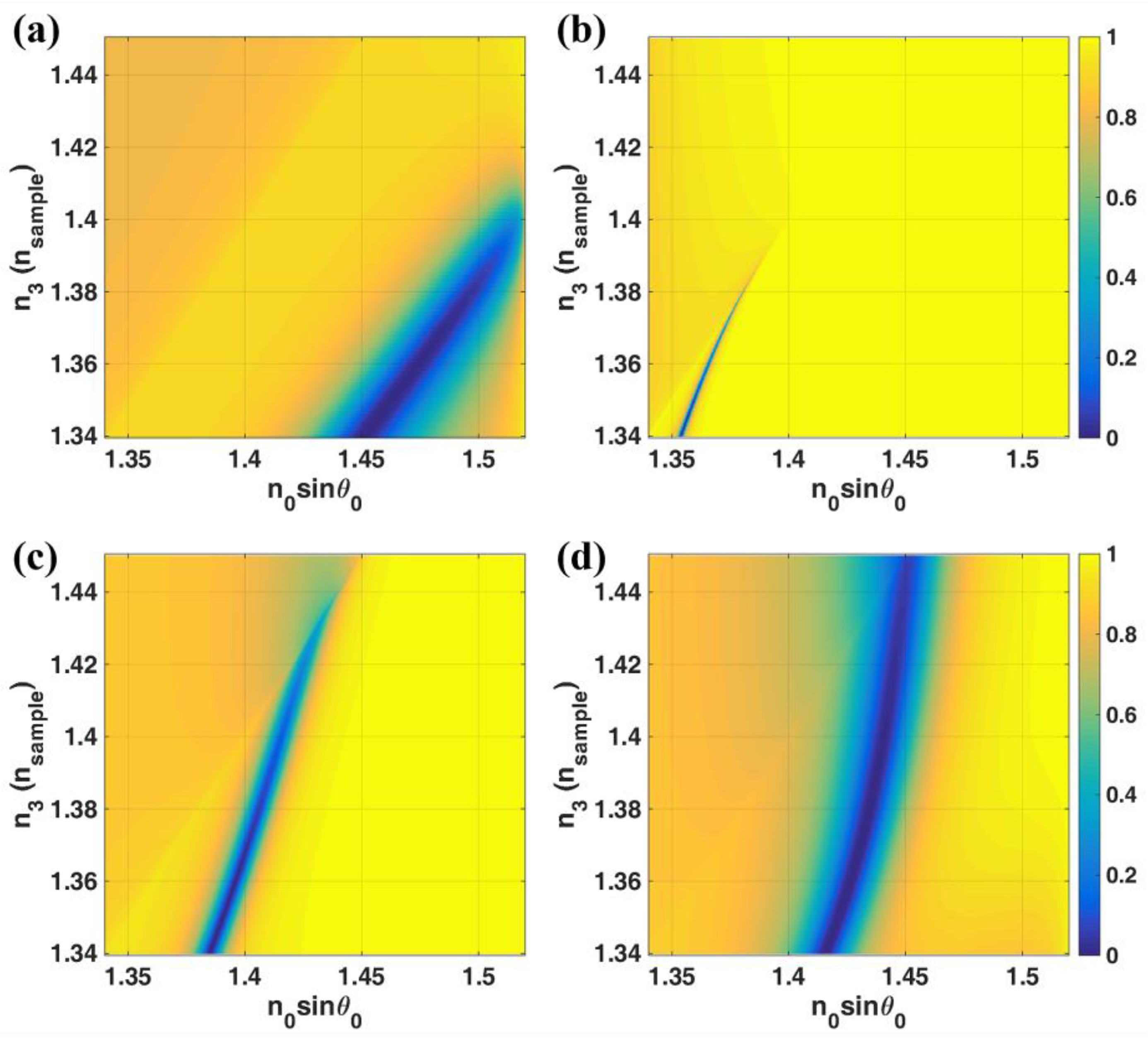
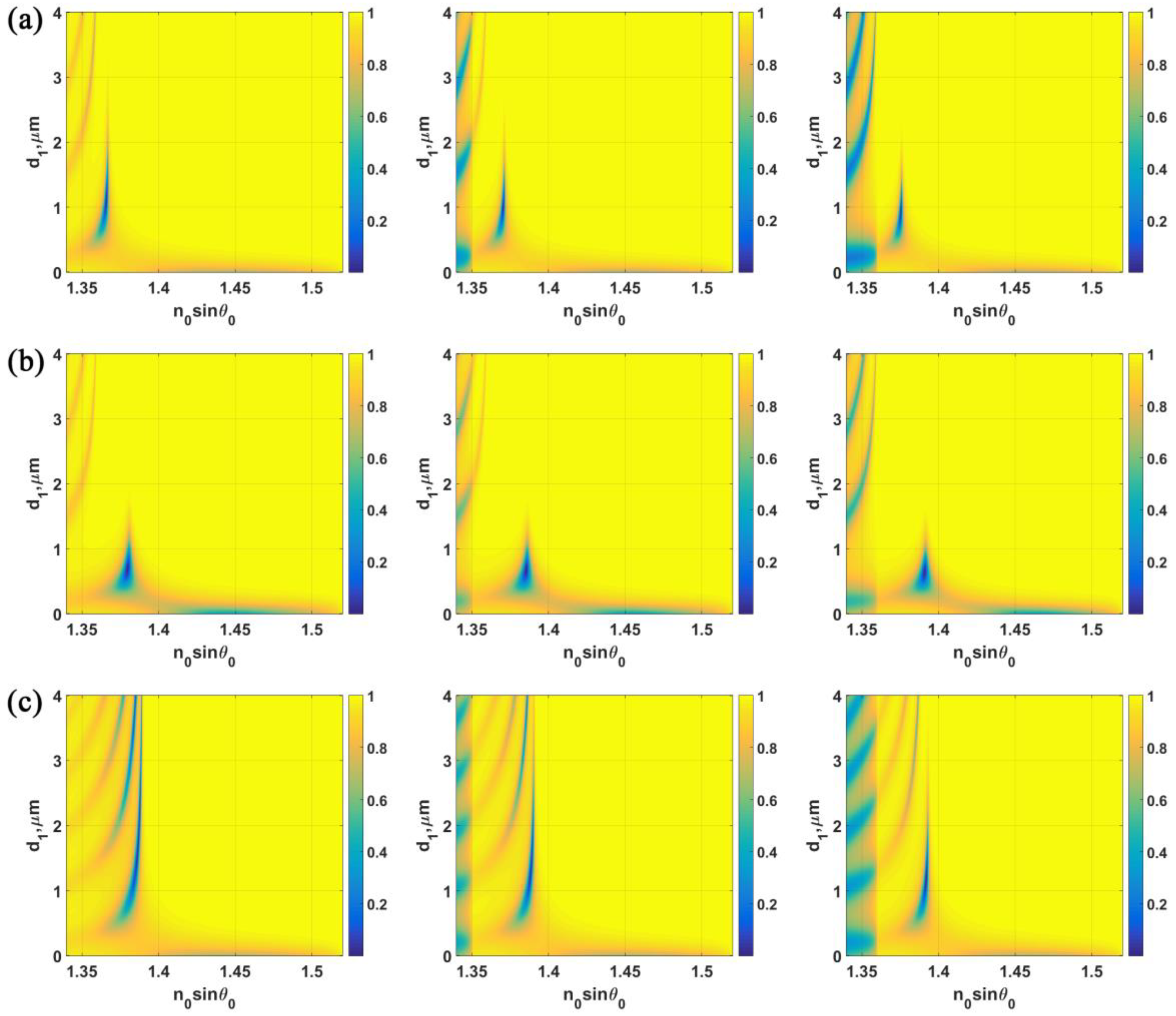

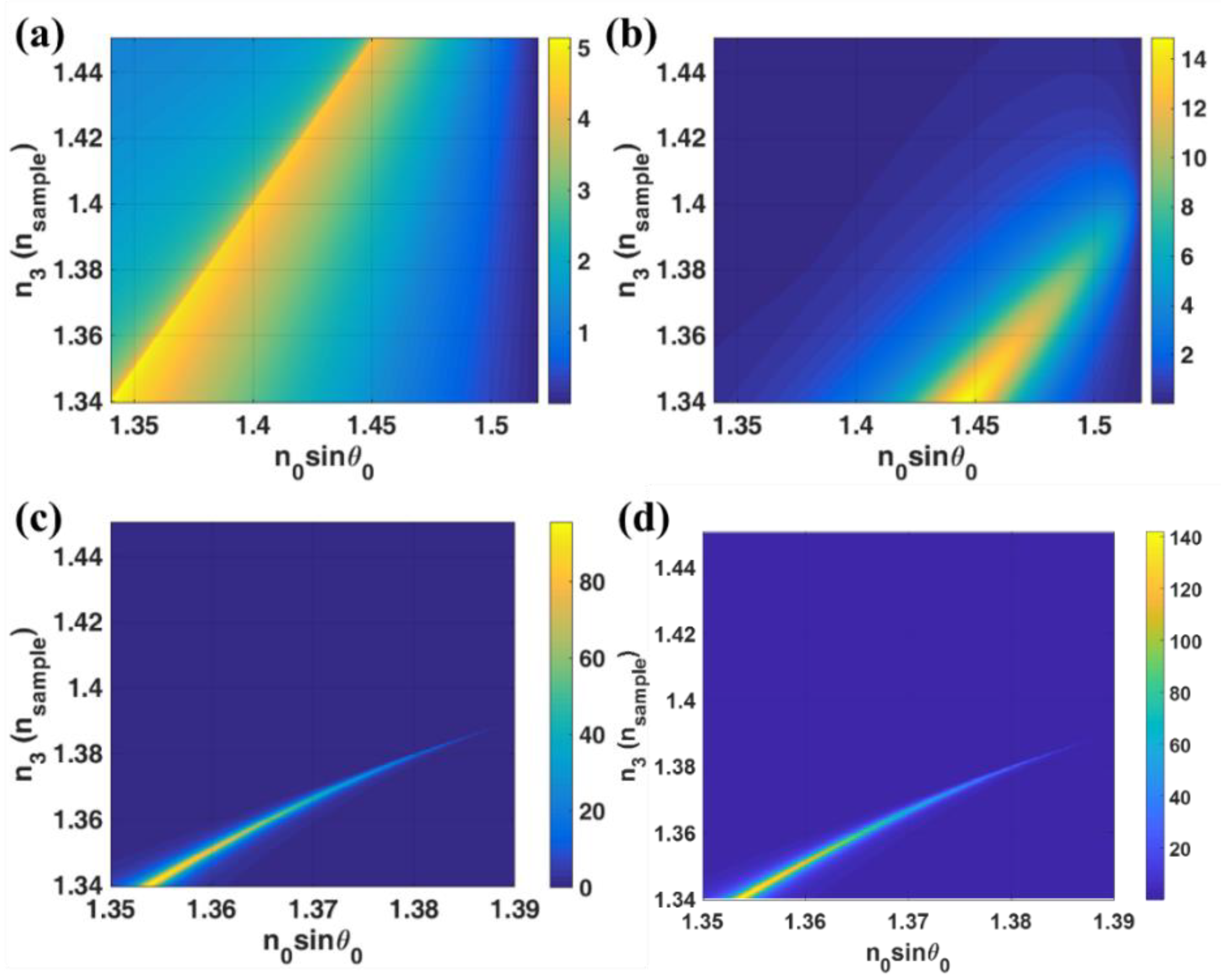
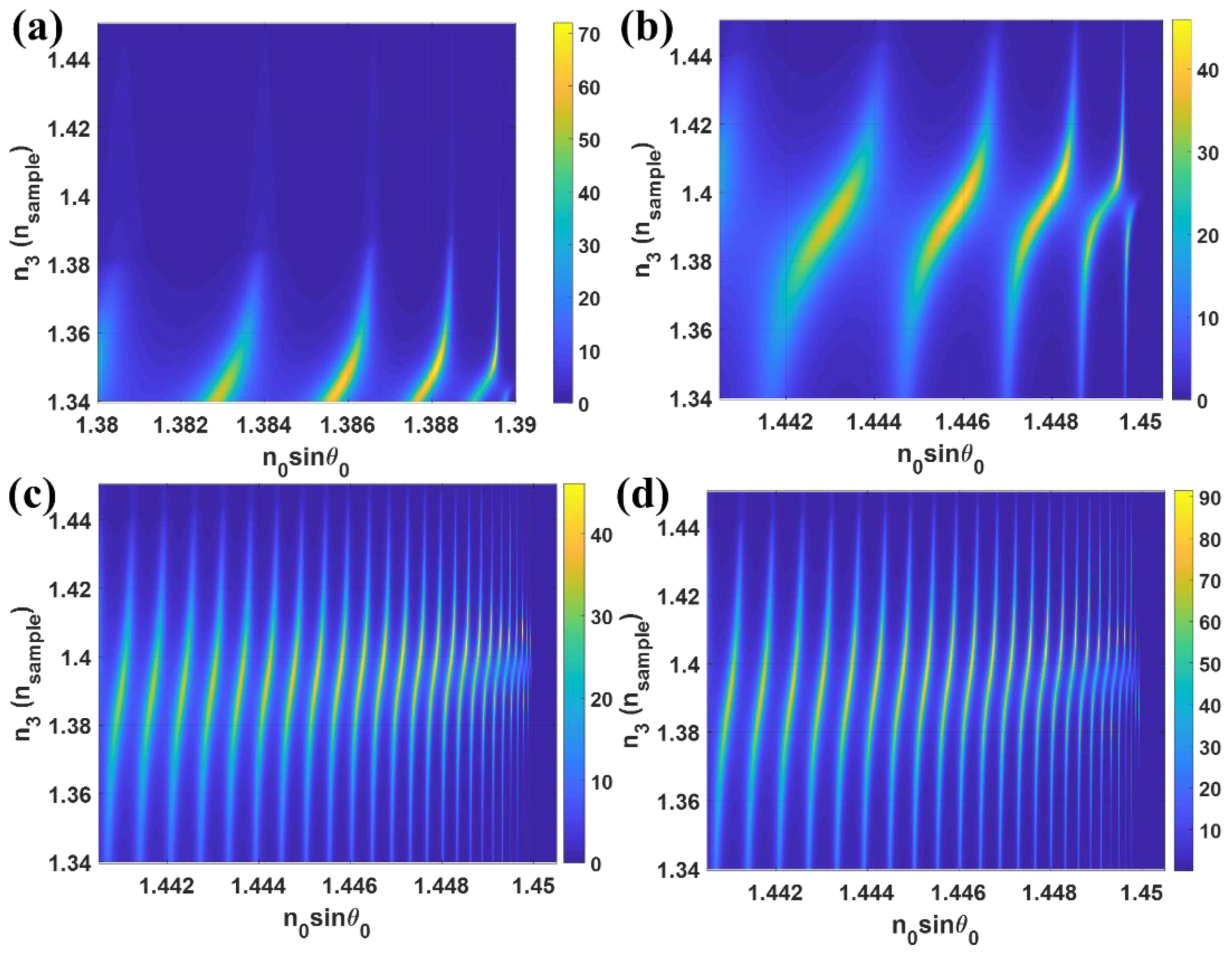


| Structure Parameters n1, d1, d2 (in nm) | Dynamic Range (D) | n0sinθ0 at Lower D Limit | n0sinθ0 at Upper D Limit | Sensitivity (S) | FWHM at |rp|2 = 0 | n0sinθ0 Where the FWHM Calculated | FoM | Shown in Figure |
|---|---|---|---|---|---|---|---|---|
| Kretschmann Configuration | ||||||||
| 1.5200, 0, 48 | 1.3400–1.3983 | 1.4510 | 1.5137 | 1.0757 | 0.0469 | 1.3400 | 22.9344 | 8a |
| LRSPP excited by evanescent wave coupling | ||||||||
| 1.3400, 930, 20 | 1.3400–1.3660 | 1.3538 | 1.3697 | 0.6127 | 0.0022 | 1.3400 | 273.6243 | 8b |
| 1.3400, 660, 30 | 1.3400–1.3885 | 1.3685 | 1.3960 | 0.5680 | 0.0056 | 1.3400 | 101.8497 | - |
| 1.3400, 510, 40 | 1.3400–1.4191 | 1.3849 | 1.4247 | 0.5030 | 0.0108 | 1.3400 | 46.4032 | 8c |
| 1.3400, 420, 50 | 1.3400–1.4485 | 1.4010 | 1.4485 | 0.4380 | 0.0176 | 1.3400 | 24.9548 | - |
| 1.3400, 360, 60 | 1.3400–1.4500 | 1.4155 | 1.4516 | 0.3276 | 0.0254 | 1.3400 | 12.9010 | 8d |
| 1.3400, 310, 70 | 1.3400–1.4500 | 1.4284 | 1.4573 | 0.2621 | 0.0371 | 1.3400 | 7.0632 | - |
| LRSPP excited by interferometric mode | ||||||||
| 1.3616, 500, 20 | 1.3955–1.4157 | 1.3971 | 1.4151 | 0.8927 | 0.0165 | 1.4092 | 54.1772 | 9a |
| 1.3616, 1000, 20 | 1.3400–1.3778 | 1.3655 | 1.3858 | 0.5374 | 0.0024 | 1.3709 | 223.4523 | 9a |
| 1.3616, 1500, 20 | 1.3400–1.3404 | 1.3665 | 1.3667 | 0.4198 | 0.0011 | 1.3665 | 373.7145 | 9a |
| 1.3616, 500, 30 | 1.3400–1.4439 | 1.3783 | 1.4439 | 0.6315 | 0.0072 | 1.4207 | 87.5131 | 9b |
| 1.3900, 500, 20 | 1.4218–1.4477 | 1.4249 | 1.4474 | 0.8673 | 0.0122 | 1.4412 | 71.0818 | 9c |
| 1.3900, 1000, 20 | 1.3400–1.4029 | 1.3829 | 1.4133 | 0.4836 | 0.0026 | 1.3984 | 182.3115 | 9c |
| 1.3900, 1500, 20 | 1.3400–1.3652 | 1.3860 | 1.3947 | 0.3456 | 0.0026 | 1.3872 | 132.2752 | 9c |
| 1.3900, 2000, 20 | 1.3400–1.3512 | 1.3873 | 1.3901 | 0.2490 | 0.0018 | 1.3873 | 138.0813 | 9c |
| 1.3900, 2500, 20 | 1.3400–1.3454 | 1.3881 | 1.3891 | 0.1840 | 0.0012 | 1.3881 | 154.6768 | 9c |
| 1.3900, 3000, 20 | 1.3400–1.3425 | 1.3885 | 1.3889 | 0.1391 | 0.0008 | 1.3885 | 170.0563 | 9c |
| 1.3900, 3500, 20 | 1.3400–1.3408 | 1.3888 | 1.3889 | 0.1073 | 0.0006 | 1.3888 | 185.0506 | 9c |
| 1.3900, 4000, 20 | 1.3400–1.3397 | 1.3890 | 1.3890 | 0.0840 | 0.0004 | 1.3890 | 199.8070 | 9c |
| 1.3900, 500, 30 | 1.3400–1.4500 | 1.3921 | 1.4570 | 0.5903 | 0.0077 | 1.4479 | 76.5967 | 9d |
| 1.3900, 1000, 30 | 1.3400–1.3477 | 1.3960 | 1.4001 | 0.5388 | 0.0042 | 1.3960 | 127.6527 | 9d |
| 1.3900, 500, 40 | 1.3400–1.4500 | 1.4093 | 1.4726 | 0.5754 | 0.0137 | 1.4170 | 42.0868 | - |
| 1.3900, 500, 48 | 1.3400–1.4067 | 1.4214 | 1.4655 | 0.6605 | 0.0138 | 1.4214 | 48.0453 | - |
© 2018 by the authors. Licensee MDPI, Basel, Switzerland. This article is an open access article distributed under the terms and conditions of the Creative Commons Attribution (CC BY) license (http://creativecommons.org/licenses/by/4.0/).
Share and Cite
Suvarnaphaet, P.; Pechprasarn, S. Enhancement of Long-Range Surface Plasmon Excitation, Dynamic Range and Figure of Merit Using a Dielectric Resonant Cavity. Sensors 2018, 18, 2757. https://doi.org/10.3390/s18092757
Suvarnaphaet P, Pechprasarn S. Enhancement of Long-Range Surface Plasmon Excitation, Dynamic Range and Figure of Merit Using a Dielectric Resonant Cavity. Sensors. 2018; 18(9):2757. https://doi.org/10.3390/s18092757
Chicago/Turabian StyleSuvarnaphaet, Phitsini, and Suejit Pechprasarn. 2018. "Enhancement of Long-Range Surface Plasmon Excitation, Dynamic Range and Figure of Merit Using a Dielectric Resonant Cavity" Sensors 18, no. 9: 2757. https://doi.org/10.3390/s18092757





